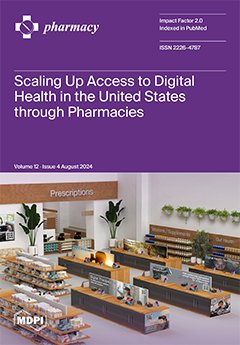This study investigated whether and how medication reviews (MRs) conducted by pharmacists and general practitioners (GPs) with patient involvement can be performed on the island of Aruba (Dutch Caribbean). In this mixed-methods pilot study (both qualitative and quantitative), constructive and observational methodologies were
[...] Read more.
This study investigated whether and how medication reviews (MRs) conducted by pharmacists and general practitioners (GPs) with patient involvement can be performed on the island of Aruba (Dutch Caribbean). In this mixed-methods pilot study (both qualitative and quantitative), constructive and observational methodologies were combined. Healthcare providers’ and patients’ views on MRs and aspects of Aruban healthcare and culture relevant to MRs were examined. These insights were used to develop a protocol for conducting and implementing MRs in Aruba. Surveys were distributed and semi-structured interviews were held among Aruban community pharmacists and GPs, and a pilot program was created in which MRs were carried out with four Aruban patients and their GPs. According to the included healthcare providers, the main purpose of MRs is to optimize the patient experience and achieve concordance. Even though pharmacists and GPs consider their partnership equal, they have different views as to who should bear which responsibility in the MR process in matters regarding patient selection and follow-up. Common Aruban themes that were mentioned by the healthcare providers and deemed relevant for conducting MRs included behaviour/culture, healthcare, lifestyle, and therapy compliance. Anamnesis should be concise during the MR, and questions about medication storage, concerns, beliefs, and practical problems, as well as checks for limited health literacy, were considered important. In the pilot, at least three to, maximally, eight pharmacotherapy-related problems (PRPs) were detected per MR consultation, such as an incorrect dosage of acetylsalicylic acid, an inappropriate combination tablet for blood pressure regulation, and the absence of important laboratory values. All patients considered their consultation to be positive and of added value. In addition, it was observed that an MR can potentially generate cost savings. The information obtained from the healthcare providers and patients, together with the basic principles for MRs, as applied in the Netherlands, led to a definitive and promising MR format with practical recommendations for community pharmacists in Aruba: in comparison with the Dutch MR approach, GPs and pharmacists in Aruba could collaborate more on patient selection for MRs and their follow-up, because of their specific knowledge regarding the medications patients are taking chronically (pharmacists), and possible low levels of health literacy (GPs). Taking into account the Aruban culture, pharmacists could ask extra questions during MRs, referring to lifestyle (high prevalence of obesity), readability of medication labels (limited literacy), and herbal product use (Latin American culture). GPs and medical specialists sometimes experience miscommunication regarding the prescription of medication, which means that pharmacists must carefully take into account possible duplicate medications or interactions.
Full article





